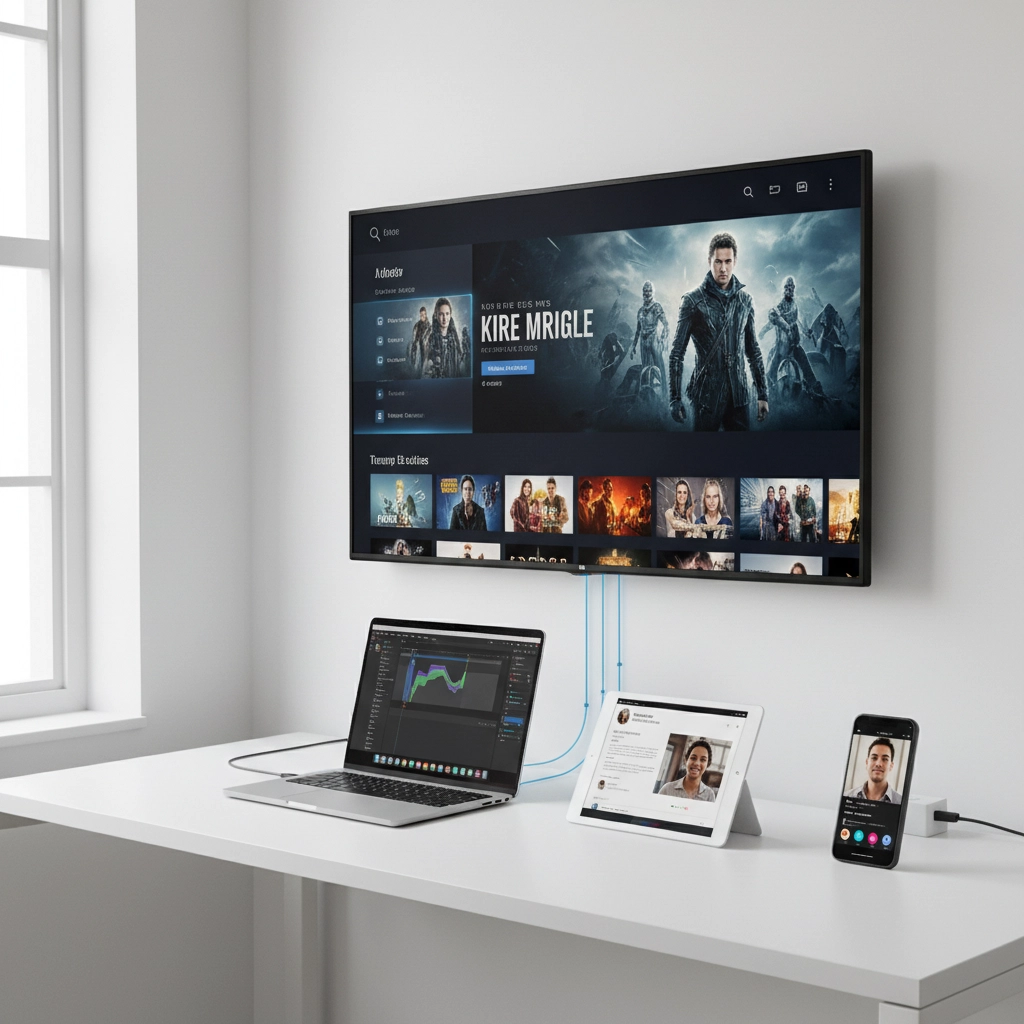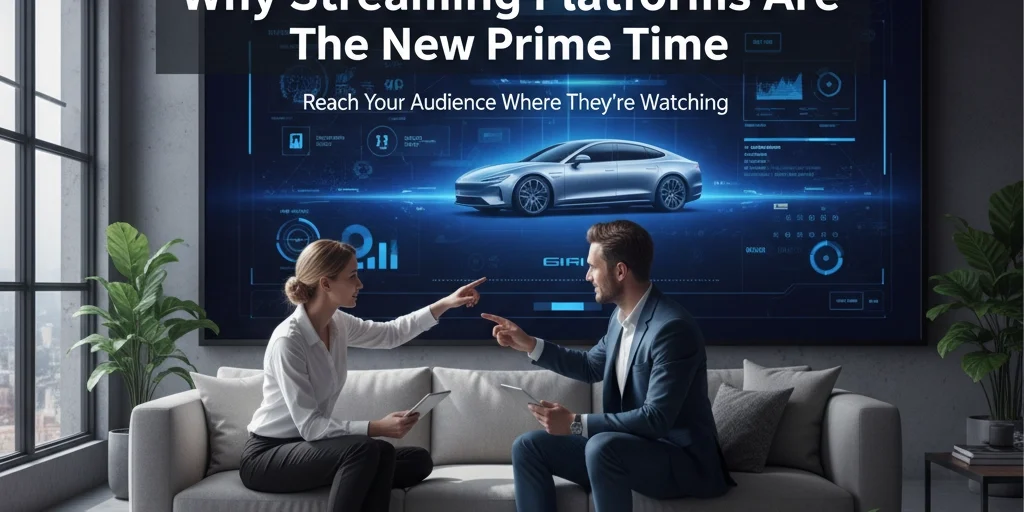The television advertising landscape has undergone a seismic transformation over the past decade. Traditional broadcast schedules and appointment viewing have given way to an on-demand ecosystem where consumers dictate when, where, and how they consume content. This shift represents more than a technological evolution: it marks the complete reimagining of what constitutes prime time advertising opportunities.
Over-the-top (OTT) television advertising has emerged as the dominant force in this new media landscape, fundamentally changing how brands reach their audiences. The numbers tell a compelling story: 88% of U.S. adults are currently subscribed to at least one streaming service, and OTT services have surpassed cable TV as the most popular means of watching televised content. This transformation has made streaming platforms the new battleground for prime advertising real estate.
Understanding OTT Television Advertising
Over-the-top advertising refers to advertisements delivered directly to viewers over the internet through streaming video services or devices, bypassing traditional distribution channels such as cable or satellite providers. The term "over-the-top" derives from the ability to circumvent traditional TV providers that historically controlled media distribution, enabling advertisers to reach audiences directly through internet-connected devices.

These advertisements appear within internet-streamed content across various devices, including smart TVs, streaming sticks, game consoles, laptops, and mobile phones. The format closely resembles traditional television commercials: typically non-skippable video advertisements shown within high-quality, long-form content, similar to traditional TV ad breaks. This approach creates a captive audience experience while combining the visual impact of television with the precision targeting capabilities of digital marketing.
The delivery mechanism represents a fundamental departure from traditional broadcasting. Rather than transmitting signals through cable or satellite networks, OTT platforms stream content directly over internet connections, providing unprecedented control over advertising delivery and measurement.
The Death of Traditional Prime Time
The concept of scheduled prime time: that coveted 8 PM to 11 PM window when families gathered around television sets: has become increasingly obsolete. Modern viewing habits have fundamentally altered the media consumption landscape, making prime time a fluid concept that occurs whenever and wherever audiences choose to engage with content.
Today's prime time happens on platforms like Netflix, Hulu, Amazon Prime Video, and Peacock rather than traditional broadcast networks. This shift reflects broader changes in consumer behavior, where convenience and control have become paramount considerations in entertainment choices. Viewers no longer structure their schedules around television programming; instead, they expect content to be available on their terms.

The statistics underscore this transformation's magnitude. Traditional television viewership has declined precipitously among younger demographics, while streaming platform subscriptions continue to grow exponentially. This migration represents more than a preference shift: it signals a permanent change in how audiences relate to media content.
The implications for advertisers are profound. The traditional model of purchasing advertising slots based on predicted audience sizes during specific time periods has been replaced by dynamic, data-driven targeting that can reach specific audience segments regardless of when they choose to watch content.
Strategic Advantages of OTT Advertising
Precision Targeting and Audience Segmentation
Unlike traditional TV advertisements that cast wide nets with limited targeting capabilities, OTT advertising enables unprecedented precision in audience selection. Advertisers can deliver messages to viewers based on demographics, interests, past viewing behavior, and even previous interactions with their brand.
This targeting sophistication extends beyond basic demographic categories. Streaming platforms collect detailed viewing data, including content preferences, viewing patterns, device usage, and engagement metrics. This information enables advertisers to create highly specific audience segments and deliver relevant messages to consumers most likely to respond positively.
The targeting capabilities also enable sequential messaging strategies, where advertisers can deliver different creative content to the same users over time, building narrative campaigns that evolve based on viewer engagement and behavior.
Enhanced Measurement and Analytics
OTT advertising provides measurement capabilities that traditional television advertising cannot match. Advertisers can track detailed metrics including completion rates, engagement levels, audience retention, and attribution across the entire customer journey.

These analytics enable real-time campaign optimization, allowing advertisers to adjust creative content, targeting parameters, and budget allocation based on performance data. The ability to measure actual viewer behavior rather than relying on statistical sampling provides advertisers with concrete evidence of campaign effectiveness.
Furthermore, OTT platforms can connect viewing behavior to downstream actions, such as website visits, app downloads, or purchase behavior, providing comprehensive attribution modeling that traditional television advertising cannot deliver.
Scalability and Campaign Flexibility
OTT advertising offers significantly greater flexibility and scalability compared to traditional television advertising. Advertisers can launch campaigns quickly, adjust targeting parameters in real-time, and scale spending up or down based on performance metrics.
This flexibility extends to creative content as well. OTT platforms support dynamic creative optimization, where different versions of advertisements can be tested simultaneously, with the best-performing content automatically receiving greater distribution. This capability enables continuous creative improvement without the lengthy production and placement cycles associated with traditional television advertising.
The scalability advantages are particularly pronounced for businesses with varying budget requirements. Unlike traditional television advertising, which often requires significant minimum spending commitments, OTT advertising can accommodate businesses of various sizes with flexible spending options.
Audience Engagement and Brand Integration
OTT advertising creates opportunities for deeper audience engagement through interactive features and seamless brand integration. Many streaming platforms support interactive advertisements that enable viewers to engage directly with content, request additional information, or take immediate action without leaving the viewing environment.
The viewing context also enhances engagement potential. Unlike traditional television viewing, which often involves distractions and multitasking, streaming platform viewing typically occurs in focused environments where viewers are actively engaged with content. This attention level creates optimal conditions for advertising message delivery and retention.
Challenges in the OTT Advertising Landscape
Despite its advantages, OTT advertising faces significant operational challenges that advertisers must navigate carefully. The primary obstacle is platform fragmentation, as the streaming ecosystem comprises numerous independent platforms, each with distinct advertising requirements, measurement systems, and audience characteristics.
This fragmentation creates complexity in campaign management and measurement standardization. Advertisers often must maintain separate relationships with multiple platforms, each requiring different creative specifications, targeting approaches, and reporting methodologies. The lack of universal measurement standards complicates efforts to assess overall campaign performance across platforms.

Additionally, the rapid evolution of the OTT landscape means that platform capabilities, pricing structures, and audience availability change frequently. Advertisers must continuously adapt their strategies to accommodate these changes while maintaining campaign effectiveness.
Privacy regulations and changing data collection practices also present ongoing challenges. As platforms adjust their data collection and targeting capabilities in response to regulatory requirements, advertisers must develop strategies that remain effective within evolving privacy constraints.
The Future of Television Advertising
The trajectory toward OTT advertising dominance appears irreversible, driven by fundamental changes in consumer behavior and technology capabilities. Industry projections indicate continued growth in OTT advertising spending as more brands recognize the platform's superior targeting and measurement capabilities.
Emerging technologies, including artificial intelligence and machine learning, promise to enhance OTT advertising effectiveness further. These technologies enable more sophisticated audience prediction, creative optimization, and attribution modeling, potentially addressing many current platform limitations.
The integration of OTT advertising with broader digital marketing ecosystems also presents significant opportunities. As measurement and targeting technologies mature, OTT advertising will likely become more seamlessly integrated with other digital marketing channels, enabling holistic campaign strategies that span multiple touchpoints.
Streaming platforms have fundamentally redefined prime time by offering on-demand access, personalized content recommendations, and precise audience targeting capabilities that traditional television cannot match. This transformation positions OTT advertising not merely as an alternative to traditional television advertising, but often as a superior option for reaching engaged, specific audiences in today's fragmented media landscape.
The evolution from scheduled broadcasting to on-demand streaming represents a permanent shift in the relationship between content, audiences, and advertisers, with streaming platforms now commanding the attention and advertising investment that traditional prime time once held. For businesses seeking to connect with modern audiences, understanding and leveraging OTT advertising capabilities has become essential for maintaining competitive advantage in an increasingly digital media environment.







